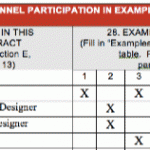
If you’ve ever proposed on Federal, or even state, A/E contracts…you’ve probably run into the Standard Form 330 (SF330).
People often struggle with the SF330. But you don’t have to.
In this post, I’m going to explain:
- How to fill out the SF330
- How to structure your information
- What to add to your submission
I’m not going to go over much of the obvious. Instead, I’ll answer common questions and give you some strategies you may have not considered.
And I’ll even give you an SF330 template that will be easy for you to use in Microsoft Word and the official directions.
What Is The SF330?
The sf330 replaced two universally hated forms (the Standard Form 255 and Standard Form 254). All Federal agencies are supposed to use the sf330 when soliciting for architecture and engineering services. Many state agencies have also adopted this form.
This new form solved a few problems:
1. Clients wanted to make sure they were getting the people with the right experience.
2. We (the industry) wanted something easier with more flexibility.
What?!?!
Yes, believe it or not, the sf330 was designed to be easy and flexible.
The first thing you need to do is change your mindset about this form. It is well thought out. And if you use it correctly, it is easy and flexible.
Keys To The SF330
If your proposed team has:
- Relevant Experience
- Worked Together Before on Relevant Projects
Then, this form will be your best friend.
If not, this form will work against you simply because it was created to weed you out. But I’m going to share some strategies that should help.
The Who and What
The sf330 revolves around the people you are proposing and the projects they worked on. Nobody wants to hire you based on your firm name or reputation. So, the who and what is critical.
Before you fill it out, you need to know who you are proposing and what they worked on. That’s because in Section G, we will need to make the connection between the key staff proposed and the experience provided.
Notice that I said, “key staff.” Unless expressly stated in the RFP, your sf330 does not need to list everybody who will work on this contract, just the “key staff.”
The Key in Key
Unless the client provides you with titles or roles they consider “key,” it is up to you to decide who is key.
Let me give you an example. Let’s say you are proposing to design a building. You know Bob, one of your mechanical designers, will work a lot on this project. However, you just hired him. He’s got no relevant experience, is not the project manager, nor is he the Lead Mechanical Designer.
Leave Bob out of your proposal. He’s not key staff. At least, not in this situation.
Then let’s say you have an electrical designer, Paul, that has tons of relevant experience, has worked with the rest of the team before, but won’t be spending as much time as Bob on the project. Put Paul in. He’s going to be key to the success of this project.
Even though Paul is spending less time on this project, the value of his contribution will be much higher. If the project runs into a snag, you’ll need the guidance of someone who has done it before. Paul is key.
We want to avoid pulling a “bait and switch.” Don’t propose the A team, but then turn around and give them the B team. Most contracts will state the key personnel cannot be changed without the client’s express written permission.
While unexpected situations and natural turnover might make complete consistency impossible, it’s just not good business to bait and switch.
Also, don’t be stupid. Your Project Manager is clearly a key person.
Nuthin’ But a Section G Thing, Baby

If you are new to the sf330 game, you should complete Section G first.
In this section, you list your proposed staff and the ten projects you will highlight in your proposal. Then you mark an X on each project the staff member worked on.
Ideally, you want to list 10 projects that are just like the one you are proposing on. You can also include one or two projects from your subconsultants in the 10. But I wouldn’t include more than two.
Logic would dictate that evaluators want to see as many x marks as possible on this form. But let me tell you, I’ve never seen evidence or even heard of an evaluation committee making their selection based solely on the number of x marks in this section.
My rule of thumb is everybody needs an x. If you list people with no x marks, you are hanging out there.
Also, if you list ten different people having worked on ten different projects, that’s also risky. You want to show these people have worked together before.
You’ll also want to show, if at all possible, that your team has worked with the subconsultant personnel in the past as well.
Sections A, B, and C
Folks, it doesn’t get any more self-explanatory than this. Sections A, B, and C are easy to fill out. Don’t spend too much time here.
But make sure everything is filled out including the percentage utilization for subconsultants.
Don’t Forget The Org Chart
Section D is the org chart. You can create this in a separate document and attach it after the first page (A, B, C).
You want to keep the org chart as simple as possible. What clients want to know is:
* Who is my single point of contact?
* Do they have enough people for this job?
* Is there a clear management structure?
* Are there any specialists on the team?
Section E The Resumes

Section E is comprised of resumes of your key staff. This would include the key staff from your subconsultants.
Typically, these resumes should be kept to one page. Some clients will allow certain resumes to go over a page. But, to my understanding, the form was designed to be a one-page resume.
Each resume should include five projects. Not four, not six, but five projects.
And don’t forget to check whether or not the project was completed while with the person’s current firm.
The Ten Year Rule
In general, the sf330 requires you to keep the experience listed in sections E and F to within the last 10 years.
Some clients will restrict this even further to three of five years. But if they don’t, it’s best to keep it to projects within the last 10 years.
Personally, I have not experienced firms getting disqualified for listing experience that went beyond 10 years. And, in a resume, if I had to choose between a project that was completed over 10 years ago and an irrelevant project, I would choose the old one. But please note, that may be a risky move.
Services vs. Construction
There are two fields after the project name. The first is “services” and the next is construction. Remember, this form was created for design firms. But it is being used for many other services.
The date services were completed is the year this person stopped providing services for this project. The construction year is when the person stopped working on the construction
The date construction was completed is when the building was opened or the renovation was complete.
The Job Titles

Ideally, you want the person’s title for his/her projects to match up with the role identified in item 13 in Section E.
For example, if this person’s role is Lead Mechanical Designer, you wouldn’t want the titles for his/her experience to read “Senior Mechanical Designer.” The client will want to know “has this person ever done this before?” If the titles on the project descriptions and role don’t match up, you are indicating that they haven’t.
Again, above all, be honest. But often people use different titles when they do the work vs when they propose on it.
For example, the person may have acted as the Project Manager on an assignment, but his/her title is listed as principal. If you are proposing for this person to be the Project Manager, that’s not going to work.
The F in Projects
In Section F, you’ll detail 10 relevant projects. Again, not six, not 11…but 10 projects.
Yes, there will be occasions where clients specifically ask for fewer projects. In all cases, give your clients what they ask for.
Time, Time, Time
In general, the projects should be within the last 10 years. Again, it is feasible that a client could restrict it to fewer years. And, just in case I’m not sounding like a broken record yet, give your clients what they ask for.
I’d be much more likely to deviate outside those 10 years in projects than in resumes.
If, between you and your subs, you can’t come up with 10 relevant projects…that may indicate a challenging competitive situation for you.
Making The Projects Relevant
You can ensure this by adding a box within the description identifying why this project is relevant. Adding a photo may also help with that.
With regards to relevancy, the term I use is “slap your clients in the face.” These projects must be so relevant that it slaps your client in the face. They shouldn’t be able to glance at a project and wonder why it’s in your sf330. It should be stupid obvious.
Yes, you can add photos and text boxes to your sf339. There are many examples of how firms do this in the presentation linked at the bottom of this post.
Subconsultant Projects
Like I said when we covered Section G, I think it’s OK to include one or two projects from subconsultants.
Don’t forget to add that your subconsultants worked on your example projects when they did. Clients will want to know how much your firms have worked together before.
Section H
Finally, at least for Part One, you have Section H. Many times clients will specify what they want to see in this section. If they do not, I would advise you to ask what they want to see in it.
Sometimes, the answer will be, “That’s up to you.” That may indicate they don’t plan to read that section. But you don’t want to take any chances. So, yes, add some information to Section H.
What you don’t want to add is boilerplate drivel from your extensive library of crap (ELC). Only add information that is relevant to this project and/or helpful to the client.
SF330 Part Two
No, this is not the sequel. Part II is the replacement for the Standard Form 254. The SF254 provided general information about your firm.
You should always include SF330 Part II in your submission unless directed by the client not to.
You really should complete one of these forms for each office (location) that will be working on the project. There are always exceptions, but that’s the general rule.
Make Sure You Have The Right Version
The most current version is rev. 8/2016. (Note: You can download the SF330 word template below.)
That version expires on 12/31/2020. Around that time, the General Services Administration (GSA) will either approve it without change or make some minor change to it. There hasn’t been a significant change in many years.
You can see the history of all changes to the sf330 over at this link.
You must also realize that some states have their own version of the SF330. For example, the state of Connecticut has a form they can the CT330. The first part of it is nearly identical to the SF330, but they tagged on a few new pages.
Just make sure you are submitting the form your client is asking for.
What If You Have Specific Questions About Filling Out The Form?
If you have any questions about filling out the form, that were not covered in this guide, I always suggest you submit a question to the contracting officer.
I should also note that you’ll find lots of useful tips below in the comments.
Conclusion
That should give you enough information to complete the form. If you want to download the free, easy to use form (Microsoft Word Format)…click the link below. I’ve also included the official sf330 directions in the download.
If you feel I left something out or have some useful sf330 advice, submit a comment below.
Useful SF330 Links
- My SF330 InDesign Template is included in my Win Writing course.














Recent Comments